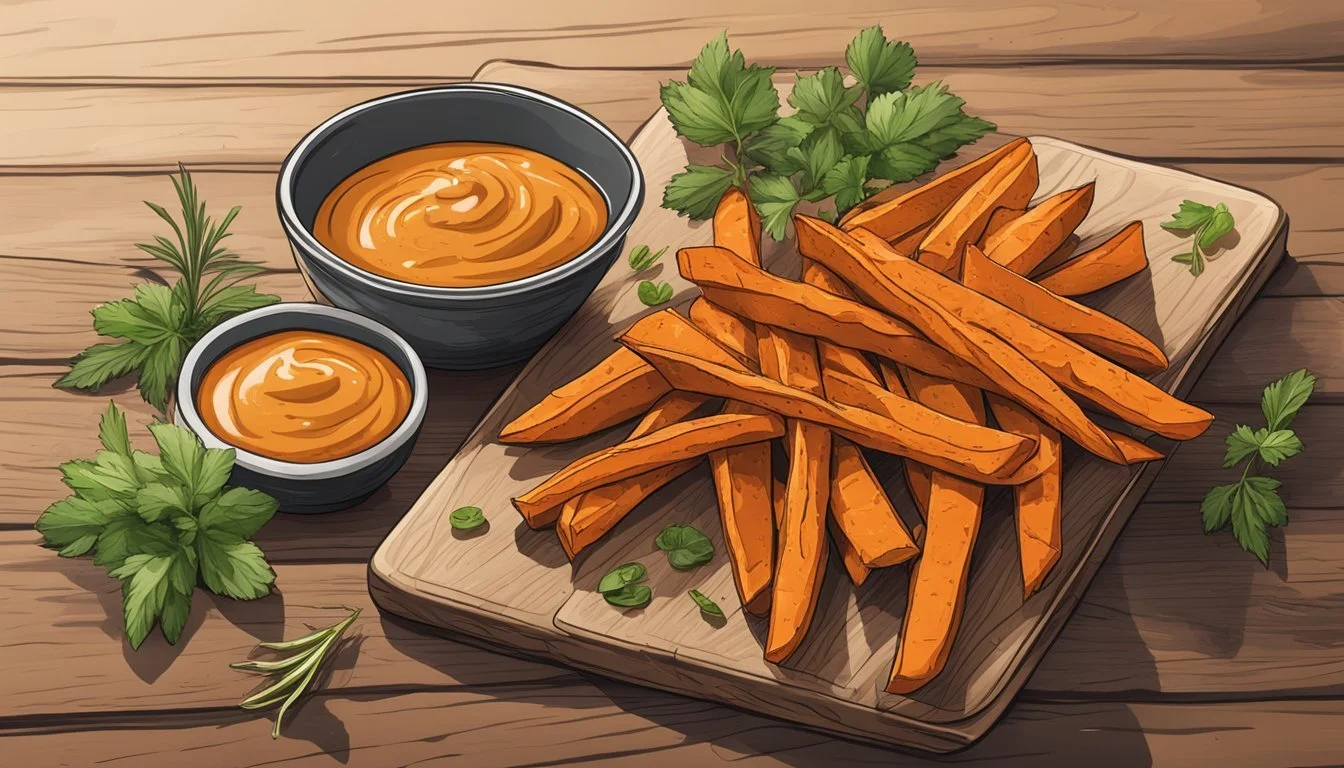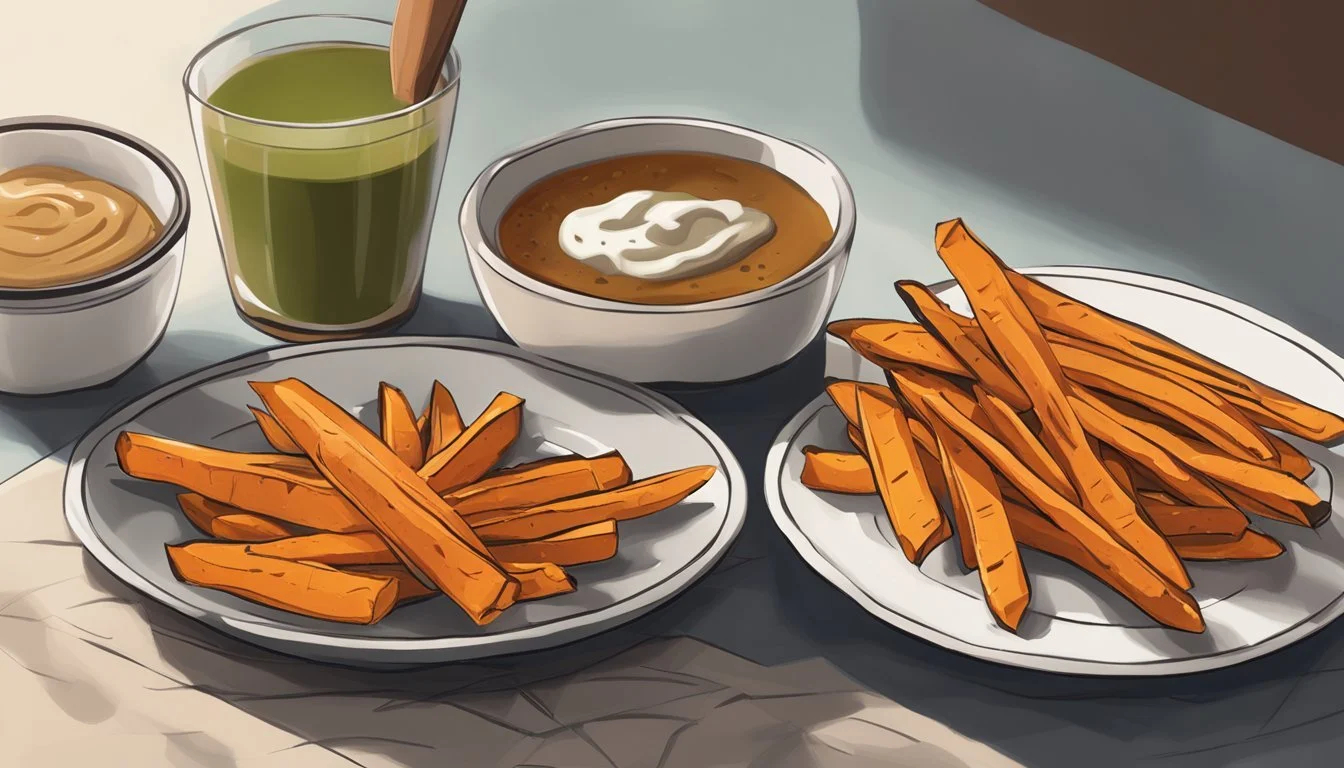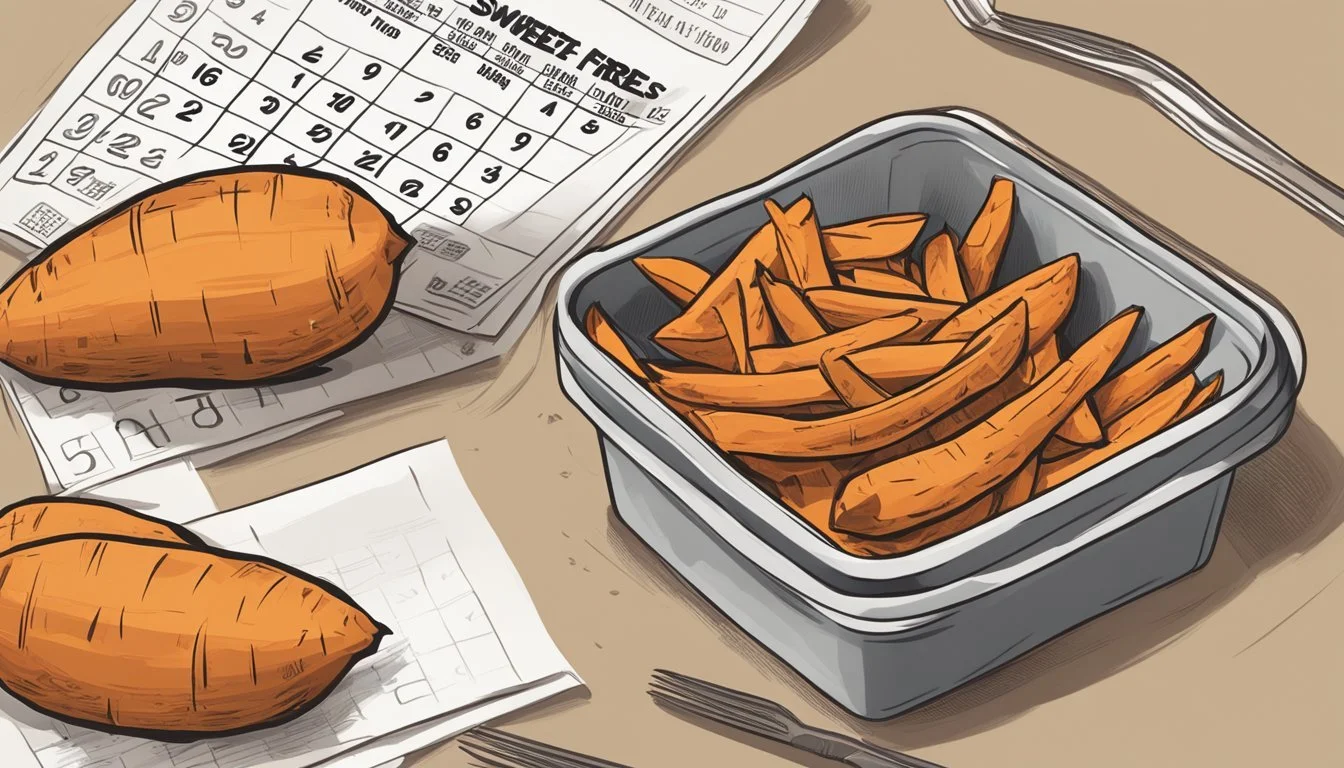How Long Do Gluten-Free Sweet Potato Fries Last?
Storage Tips and Shelf Life
For those maintaining a gluten-free diet, knowing the shelf life of prepared foods is crucial, especially for healthier options like sweet potato fries. Gluten-free sweet potato fries not only cater to dietary restrictions but also pack a nutritional punch with their high fiber and vitamin content. When stored properly in an airtight container, these fries can last up to three to five days in the refrigerator, making them a convenient option for quick, healthy meals.
If you're keen on meal prepping, freezing sweet potato fries can extend their longevity to up to three months. It's essential to allow them to cool completely before placing them in freezer-safe bags to retain their crispiness upon reheating. Their nutritional benefits remain intact, ensuring you have a healthy, fiber-rich snack or side dish ready whenever you need it.
The combination of their gluten-free nature and health benefits makes sweet potato fries a winner in many households. With proper storage techniques, you can enjoy the convenience of having these nutritious fries on hand, minimizing food waste without compromising on diet or taste.
Understanding Gluten-Free Sweet Potato Fries
Gluten-free sweet potato fries offer a delicious alternative for those avoiding gluten. These fries not only cater to gluten-sensitive individuals but also pack nutritional benefits.
Benefits of Gluten-Free Options
Gluten-free sweet potato fries are essential for individuals with celiac disease or gluten sensitivity. By removing gluten, these fries prevent adverse reactions such as digestive discomfort or inflammation.
These fries are naturally dairy-free and can be seasoned with various gluten-free spices, enhancing their flavor without compromising health. Additionally, opting for gluten-free versions can help those aiming for a healthier diet by avoiding processed ingredients often found in commercial fries.
Sweet Potato Nutrition Facts
Sweet potatoes are nutrient-dense, making the fries a healthy choice. They are rich in vitamin A, vitamin C, and fiber. A single serving can provide a significant portion of the daily recommended intake of these essential nutrients.
Sweet potatoes also offer antioxidants which help in combatting oxidative stress. Furthermore, they have a lower glycemic index compared to regular potatoes, leading to more stable blood sugar levels. For those watching their carbohydrate intake, these fries are a nutritious and wholesome option.
Differences Between Regular and Gluten-Free Fries
Regular fries, often made from white potatoes, sometimes contain flour to enhance crispiness. This makes them unsuitable for individuals avoiding gluten. In contrast, gluten-free sweet potato fries avoid such additives, relying on natural or gluten-free coatings.
Sweet potato fries generally have a distinct flavor and a slightly sweeter taste compared to regular fries. Additionally, their higher fiber content promotes better digestive health. The preparation methods may also differ, with gluten-free versions often baked rather than fried to maintain health benefits.
Opting for homemade gluten-free sweet potato fries ensures control over ingredients, making them a healthier and safer choice for those with dietary restrictions.
Selecting Quality Ingredients
To make delicious and long-lasting gluten-free sweet potato fries, it is important to focus on selecting the right sweet potatoes, using optimal oils for baking and frying, and adding seasonings that enhance the flavor.
Choosing the Right Sweet Potatoes
Selecting quality sweet potatoes is crucial for ensuring the best taste and texture of your fries. Aim to buy sweet potatoes that are fat, long, and have smooth, unblemished skins. Avoid those with signs of spoilage such as roots or grayish-brown spots. Fresh sweet potatoes stored at room temperature can last about two weeks.
Optimal Oils for Baking and Frying
The type of oil you use can greatly affect the taste and crispiness of your fries. Olive oil is an excellent choice for baking due to its robust flavor and health benefits. For frying, options like avocado oil or canola oil are also good choices, as they have higher smoke points.
Seasonings and Flavor Enhancements
Seasoning your gluten-free sweet potato fries can elevate their taste profile. Basic seasonings such as sea salt, black pepper, and garlic powder are essentials. To add a bit of heat, include chili powder or paprika. Toss the fries in mixed seasonings before baking to ensure an even coating and enhanced flavor.
Preparation Techniques
Ensuring the best gluten-free sweet potato fries involves careful attention to peeling, cutting, soaking, and coating. These steps guarantee fries that are crispy, flavorful, and ready to store.
Peeling and Cutting
Start by peeling the sweet potatoes with a peeler. Choose whether to leave the skin on for added texture or peel it off completely.
Once peeled, use a sharp knife to cut the sweet potatoes into uniform wedges or fries, aiming for a thickness of about ¼ inch. Consistency in size is crucial to ensure even cooking and crispiness.
The Importance of Soaking
Soaking the cut sweet potato wedges in cold water helps remove excess starch. This step is vital for achieving a crispy exterior.
Place the cut fries in a bowl of cold water and refrigerate for at least 30 minutes. For best results, change the water a couple of times during the soaking process.
Drying and Coating for Crispiness
After soaking, thoroughly dry the sweet potatoes using a clean towel. Removing as much moisture as possible is key to preventing soggy fries.
Next, lightly coat the dried wedges in a thin layer of cornstarch. This extra step enhances the crispiness.
For oven-baked fries, a mixture of olive oil, salt, and seasonings can be tossed with the coated fries before baking at around 400-425°F.
Adjust the bake time to ensure the fries turn golden brown and crispy.
Baking and Frying Instructions
To achieve delicious, gluten-free sweet potato fries, choose between baking, air frying, or traditional frying. Each method provides a unique texture and flavor. Specific steps ensure the fries come out crispy and tasty.
Oven-Baked Sweet Potato Fries
Preheat the oven to 425°F (220°C). Wash and peel the sweet potatoes if desired, then cut them into fries about ¼ inch thick. Place the fries in a bowl and coat them evenly with 1-2 tablespoons of olive oil. Add spices like sea salt, black pepper, and garlic powder.
Line a baking sheet with parchment paper or foil. Spread the fries in a single layer to ensure even cooking. Bake for 20 minutes. Flip the fries and bake for another 10-15 minutes until crispy and lightly browned.
Air Fryer Method for Sweet Potato Fries
Preheat the air fryer to 400°F (200°C). Prepare the sweet potatoes by peeling and slicing them into ¼ inch thick fries. Toss the fries in a bowl with 1 tablespoon of oil and season with your preferred spices.
Place the fries in the air fryer basket in a single layer to ensure even air circulation. Cook for 10-12 minutes, shaking the basket halfway through to promote even cooking. Check for a golden-brown color and crispiness.
Frying Gluten-Free Sweet Potato Fries
Heat a pot of oil to 350°F (175°C) using a deep-fry thermometer for accuracy. Prepare the sweet potatoes by washing and cutting them into fries, about ¼ inch thick. Ensure the fries are dry to prevent oil splatter.
Carefully add the fries to the hot oil in batches to prevent overcrowding. Fry for 3-4 minutes until they are golden and crispy. Remove with a slotted spoon and place on a plate lined with paper towels to drain any excess oil. Season immediately with salt while hot.
Optimal Storage Solutions
Proper storage of gluten-free sweet potato fries ensures they maintain their flavor and texture. The key methods include refrigeration for short-term use and freezing for extended preservation. Employing these strategies maximizes the fries' lifespan while minimizing waste.
Short-Term Preservation
To preserve gluten-free sweet potato fries for a few days, store them in the refrigerator. Let the fries cool completely to room temperature before placing them in an airtight container. This container should prevent exposure to moisture and air, which could degrade the fries.
Store the airtight container in the fridge for up to 3-5 days. When ready to serve, reheat the fries in an oven preheated to 375°F for about 10 minutes to retain their crispiness. For added crispiness, briefly broiling them for the last 2-3 minutes of reheating helps.
Long-Term Freezing Tips
For longer storage, freezing is the best option. Start by arranging the fries in a single layer on a baking sheet and flash freeze them for 1-2 hours. This prevents them from sticking together. Transfer the frozen fries to a freezer-safe, airtight container or ziplock bag.
Label the container with the date of freezing. Frozen gluten-free sweet potato fries retain their quality for up to 3 months. To reheat, bake the fries directly from the freezer in an oven preheated to 425°F for about 20-25 minutes. This maintains their texture and flavor effectively.
Serving and Pairing Ideas
Gluten-free sweet potato fries can be enhanced with creative dipping sauces and toppings to elevate their flavor. They also make a versatile side dish that pairs well with various meals.
Dipping Sauces and Toppings
Sweet potato fries pair well with a variety of dipping sauces. Ketchup and ranch dressing are popular choices for their contrasting flavors. For a zesty twist, try mixing sriracha with mayonnaise.
Garlic aioli is a sophisticated option that complements the natural sweetness of the fries. When it comes to toppings, sprinkle fries with freshly chopped parsley or a mix of paprika, garlic powder, and salt for extra flavor. Grated Parmesan can also add a cheesy touch that's hard to resist.
Incorporating into Meals as a Side Dish
Sweet potato fries are a versatile side dish that can be served alongside many main courses. They pair well with grilled proteins like chicken, steak, or fish. For a hearty meal, serve them alongside a burger—gluten-free buns can keep the whole meal gluten-free.
Incorporate them into a mixed greens salad, adding both texture and flavor. For a vegetarian option, serve sweet potato fries with a hearty black bean burger. Offering them as a side dish at a casual BBQ or a more formal dinner ensures a delightful and accommodating option for any occasion.
Adapting Recipes to Dietary Needs
Gluten-free sweet potato fries can be adapted to meet various dietary needs. These adaptations can make them suitable for a range of preferences and health goals, including vegan, allergy-friendly, caloric, and nutritional considerations.
Vegan and Allergy-Friendly Variations
For those following a vegan or allergy-friendly diet, ensuring that sweet potato fries are free from animal products and common allergens is essential. Substitute butter with olive or avocado oil for a vegan-friendly and dairy-free option.
Avoid using garlic powder if there's a garlic allergy. Use herbs like rosemary or thyme instead. When preparing the fries, ensure that the cooking utensils and surfaces are free from cross-contamination with gluten or other allergens.
For an extra crunch, consider adding a gluten-free breadcrumb coating, which is vegan-friendly and allergen-free. Always read labels to guarantee that ingredients are safe for those with specific dietary restrictions.
Caloric and Nutritional Considerations
When adapting sweet potato fries to fit certain caloric and nutritional needs, focus on the cooking methods and ingredient choices. Baking instead of frying significantly reduces the calorie content while maintaining a delicious flavor. Opt for healthy oils like avocado oil, which is high in beneficial fats.
Seasonings play a crucial role in the nutritional profile. Instead of using sugar-laden spices, prefer natural spices such as paprika or cumin which add flavor without extra calories.
A small serving size of sweet potato fries (around 100 grams) contains approximately 100 calories, making them a low-calorie but filling choice. Sweet potatoes are also rich in vitamins A and C, fiber, and potassium, contributing to overall nutrient intake.
By making informed ingredient choices and cooking methods, one can enjoy sweet potato fries that cater to specific nutritional and caloric preferences.
Common Challenges and Solutions
Making gluten-free sweet potato fries at home can present several challenges, including achieving the desired level of crispiness and avoiding common pitfalls like sogginess and overcrowding on the baking sheet.
Preventing Soggy Fries
Soggy sweet potato fries can be a result of moisture retention during baking. To avoid this, it's crucial to thoroughly dry the sweet potatoes after washing and peeling them.
Using a kitchen towel to pat the fries dry can make a significant difference. Coating the fries evenly with a small amount of oil helps to create a barrier that prevents moisture from seeping in.
Proper baking temperatures also play a role. Baking at around 425°F ensures that the fries cook quickly enough to become crispy and not absorb excess moisture. Use a wire rack if possible; it allows hot air to circulate around the fries, aiding in even cooking and reducing moisture accumulation.
Avoiding Overcrowding During Baking
Overcrowding the fries on the baking sheet leads to steaming rather than baking, causing them to stay soggy. To avoid this, make sure to lay the fries in a single layer with enough space between them.
Using two baking sheets, if needed, ensures each fry has room to crisp up properly. Convection settings can also help by promoting even heat distribution. Turning the fries halfway through the baking process ensures even crisping on all sides.
Crispiness Troubleshooting
Achieving perfectly crispy sweet potato fries can be tricky but is certainly possible. One key technique involves soaking the cut fries in cold water for at least an hour before baking. This process removes excess starch, which can prevent the fries from becoming crispy.
Dry the fries thoroughly after soaking. Tossing the fries with cornstarch before adding oil can also help create a crispy outer layer. Seasoning should be added after the fries come out of the oven to avoid drawing out moisture during the baking process.
Ensuring your oven is pre-heated properly and maintaining a consistent temperature throughout the baking time can significantly affect the fries' crispiness.
Enhancing Your Sweet Potato Fries
Enhancing your sweet potato fries involves mastering techniques for perfect fries, experimenting with creative flavor combinations, and focusing on presentation to elevate their appeal. Small adjustments can make a big difference.
Expert Tips for Perfect Fries
Here are some expert tips for achieving the perfect gluten-free sweet potato fries.
First, use fresh sweet potatoes and cut them uniformly to ensure even cooking. Coating the fries in a mixing bowl with a mix of olive oil and seasonings will help them crisp up. Preheating the oven is crucial; temperatures between 400°F and 450°F work best. A step often overlooked is not overcrowding the baking sheet to allow for airflow.
Turning the fries halfway through baking ensures uniform crispiness. A light dusting of cornstarch before baking can also enhance the texture.
Creative Flavor Combinations
Sweet potato fries are versatile and can be paired with a wide range of flavors.
For a spicy kick, try a blend of chili powder and garlic powder.
For a sweet and salty combination, add fine sugar with a sprinkle of sea salt.
Herb lovers will enjoy rosemary and thyme mixed with olive oil.
For something different, a hint of cinnamon and brown sugar can turn these fries into a treat.
For a more sophisticated palette, a mix of smoked paprika and cumin delivers a depth of flavor. These combinations require minimal effort but offer maximum flavor impact, so don't be afraid to experiment and find your favorite mix.
Presentation and Plating
Presentation enhances the eating experience. Use an attractive bowl or basket lined with parchment paper for a rustic touch.
Sprinkle fresh herbs or finely grated parmesan on top for visual appeal. Serve with a side of dips like garlic aioli, spicy ketchup, or honey mustard in small dipping bowls.
Arrange the fries neatly rather than piling them up to keep them from getting soggy. Presentation matters not just for looks but for maintaining the texture and flavor of your fries.
Using these techniques, your sweet potato fries will not only taste great but look appetizing too.










